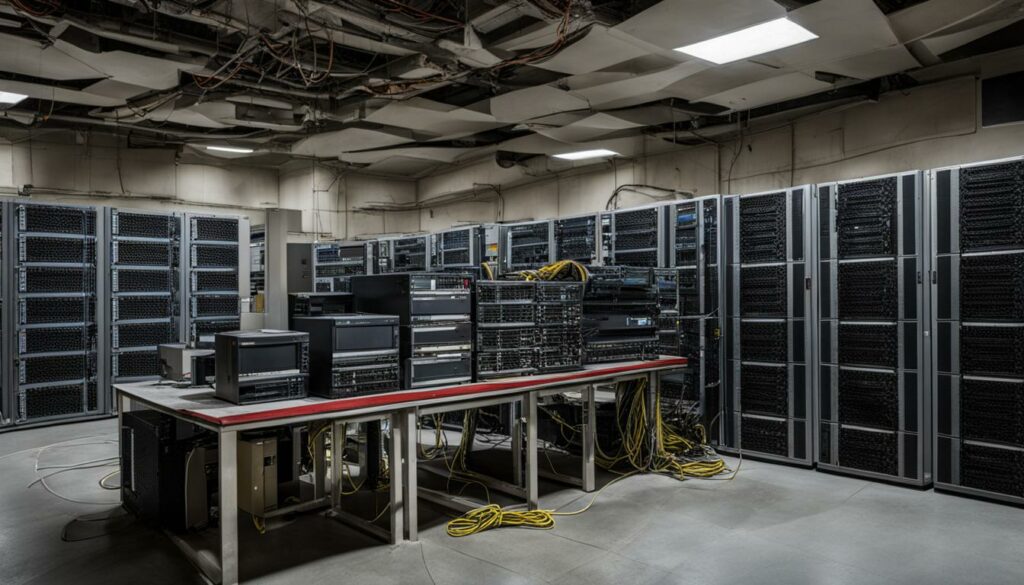The Comprehensive Guide to Network Equipment Decommissioning
Network equipment decommissioning is a crucial process that involves removing servers and other hardware from an organisation’s infrastructure. This process is important for maintaining security, protecting data, and ensuring stability within the network. It typically takes around two to three weeks to complete the decommissioning process, which includes tasks such as backing up data, removing hardware from the network, and disposing of equipment properly. Failing to decommission network equipment properly can lead to security vulnerabilities and inefficiencies within the organisation.
- Proper network equipment decommissioning is crucial for maintaining security and stability within the network.
- The process typically takes two to three weeks and includes tasks such as data backup and equipment disposal.
- Failing to decommission network equipment properly can lead to security vulnerabilities and inefficiencies.
- Organisations should follow best practices and document the decommissioning process.
- Network equipment decommissioning offers benefits such as improved efficiency, cost savings, and equipment consolidation.
What is Network Equipment Decommissioning?
Network equipment decommissioning is the process of safely removing servers and other hardware from an organization’s infrastructure. It goes beyond simply turning off the server; network equipment decommissioning involves careful consideration of security, data preservation, and network stability. This process typically takes two to three weeks to complete and includes tasks such as backing up data, removing hardware from the network, and ensuring proper disposal of equipment.
During network equipment decommissioning, it is important to prioritize data security. This means securely removing all sensitive data from the servers before disposal. It also involves backing up important data and license details to preserve critical information. Additionally, the decommissioning process may require replacing the decommissioned server with a suitable replacement to maintain network stability.
Network equipment decommissioning is a necessary step in maintaining a secure and efficient network infrastructure. By carefully planning and executing the decommissioning process, organizations can ensure the proper disposal of hardware, protect sensitive data, and prevent security vulnerabilities.
The Importance of Network Equipment Decommissioning
“Network equipment decommissioning is essential for maintaining security, protecting data, and ensuring stability within the network.”
Network equipment decommissioning helps organizations maintain the security and integrity of their network infrastructure. By removing obsolete or outdated equipment, organizations can reduce the risk of security breaches and vulnerabilities. Proper decommissioning also ensures that sensitive data is securely removed from servers before disposal, mitigating the risk of data breaches.
Furthermore, network equipment decommissioning allows organizations to optimize their network infrastructure by removing unnecessary hardware and consolidating resources. This can result in cost savings, improved efficiency, and easier network management. By following decommissioning best practices and considering the specific needs of their organization, businesses can ensure a smooth and successful decommissioning process.
Key Points:
- Network equipment decommissioning involves safely removing servers and hardware from an organization’s infrastructure.
- It requires careful consideration of security, data preservation, and network stability.
- Proper decommissioning ensures secure data removal, backup of important information, and replacement with suitable hardware.
- Network equipment decommissioning is essential for maintaining network security and efficiency.
- It allows organizations to reduce the risk of security breaches, optimize network infrastructure, and improve efficiency.
| Decommissioning Process | Decommissioning Strategies |
|---|---|
| 1. Back up important data and license details | 1. Assess the organization’s specific needs and requirements |
| 2. Remove hardware from the network | 2. Create a detailed decommissioning plan |
| 3. Securely remove all sensitive data from servers | 3. Coordinate with relevant departments and stakeholders |
| 4. Dispose of equipment properly | 4. Ensure compliance with regulatory obligations |
Best Practices for Network Equipment Decommissioning
When it comes to network equipment decommissioning, following best practices is crucial to ensure a smooth and secure process. By implementing these practices, organizations can minimize the risks associated with decommissioning and maximize the efficiency of their network infrastructure. Here are some key recommendations to consider:
Planning and Scheduling
Proper planning and scheduling are essential to ensure that the decommissioning process is well-executed. Establishing milestones and timelines helps keep the project on track and ensures that all necessary tasks are completed in a timely manner. It is important to involve all relevant stakeholders and allocate resources accordingly to avoid any disruptions to business operations.
Data Backup and Removal
Prior to decommissioning any network equipment, it is critical to back up all important data and license details. This ensures that valuable information is preserved and can be easily accessed if needed in the future. Additionally, it is crucial to remove all data and information from the hardware to prevent any potential data breaches or unauthorized access.
Isolation and Disconnection
Taking the server off the network and disconnecting the hardware are the final steps in the decommissioning process. It is important to isolate the server from the network to prevent any potential security risks. Disconnecting the hardware ensures that it is no longer consuming power and occupying valuable rack space. Proper documentation of these steps is essential for future reference and tracking purposes.
| Best Practices | Description |
|---|---|
| Planning and Scheduling | Establish milestones and timelines, involve stakeholders, allocate resources |
| Data Backup and Removal | Back up important data and license details, remove all data from hardware |
| Isolation and Disconnection | Take server off the network, disconnect hardware, document the steps |
By following these best practices, organizations can streamline the network equipment decommissioning process and ensure a secure and efficient transition. It is important to remember that each decommissioning project may have unique requirements, so adapting these practices to specific needs is crucial for success.

Common Challenges in Network Equipment Decommissioning
Network equipment decommissioning presents various challenges that organizations need to address to ensure a smooth transition. Here are some of the common challenges encountered during the decommissioning process:
Time Consumption
One of the main challenges in network equipment decommissioning is the time it takes to complete the process. Decommissioning can be a time-consuming task, often requiring several weeks or even months to properly remove and dispose of hardware. This can impact other tasks and projects within the organization, as resources and personnel are allocated to the decommissioning process.
Administration
Managing the administration and logistics involved in network equipment decommissioning can be complex and demanding. It requires careful coordination and attention to detail to ensure that all necessary steps are completed, including data backup, hardware removal, and disposal. Effective administration is crucial to avoid disruptions and ensure the efficient execution of the decommissioning process.
Resource Allocation
Proper resource allocation is another challenge in network equipment decommissioning. Organizations must allocate the necessary resources, including personnel, equipment, and budget, to carry out the decommissioning process effectively. Insufficient resource allocation can lead to delays, inefficiencies, and potential security risks if the process is not adequately managed.
The Importance of Documentation in Network Equipment Decommissioning
Documentation plays a crucial role in the network equipment decommissioning process. It ensures consistent performance across organizational teams and helps to ensure that everyone follows the same processes and procedures. Proper documentation includes maintaining an accurate asset inventory, which includes important details such as device name, IP address, vendor name, device model, and more. This information is vital for effective asset management and meeting compliance obligations.
By having thorough documentation, organizations can accurately assess the value of assets throughout their lifecycle and during the decommissioning process. This helps to avoid unnecessary asset purchases and ensures the proper disposal of equipment. Additionally, documentation plays a critical role in data security. It ensures that all sensitive information is properly handled, protected, and disposed of in accordance with regulatory requirements.
Proper documentation is the cornerstone of a successful network equipment decommissioning project. It enables organizations to streamline the process, maintain data integrity, and comply with legal and industry standards.
The Benefits of Documentation:
- Consistent performance across teams
- Accurate asset inventory management
- Data security and compliance
- Efficient asset lifecycle management
- Streamlined decommissioning process
Organizations that prioritize documentation in their network equipment decommissioning efforts can ensure the efficient and secure disposal of hardware, protect sensitive data, and comply with regulatory obligations. By following best practices and maintaining a comprehensive documentation system, organizations can successfully navigate the decommissioning process and optimize their network infrastructure for future growth and success.
| Documentation Benefits | Description |
|---|---|
| Consistent performance across teams | Proper documentation ensures that all teams follow the same processes and procedures, leading to consistent performance and results. |
| Accurate asset inventory management | Maintaining an accurate asset inventory allows organizations to effectively manage their hardware assets and make informed decisions. |
| Data security and compliance | Thorough documentation ensures that sensitive data is handled and disposed of properly, meeting compliance obligations and minimizing security risks. |
| Efficient asset lifecycle management | By documenting the value and condition of assets throughout their lifecycle, organizations can optimize their asset management strategies. |
| Streamlined decommissioning process | Documentation helps organizations plan and execute the decommissioning process efficiently, minimizing disruption and maximizing effectiveness. |
The Benefits and Considerations of Network Equipment Decommissioning
Network equipment decommissioning offers several benefits for organizations. By closing or relocating data centers, organizations can experience improved speed, efficiency, and cost savings. This can be achieved by leveraging cloud services or colocation facilities, which reduce overhead and increase agility. Additionally, decommissioning presents an opportunity for equipment consolidation, bringing all hardware into one central location for streamlined management and maintenance.
However, there are several considerations to keep in mind when embarking on a network equipment decommissioning project. One of the main considerations is the potential disruption to business operations during the decommissioning process. It’s crucial to carefully plan and execute the project to minimize any negative impact on the organization’s day-to-day activities.
“Network equipment decommissioning offers cost savings and greater efficiency through data center closure or relocation to cloud services or colocation facilities.”
Another key consideration is data security. Organizations must ensure that sensitive data is securely transferred or disposed of during the decommissioning process to protect against potential breaches. Compliance with regulatory obligations is also essential to avoid any legal or financial consequences. By prioritizing data protection and compliance, organizations can maintain a robust and secure network environment throughout the decommissioning process.
| Benefits | Considerations |
|---|---|
| Improved speed and efficiency | Potential disruption to business operations |
| Cost savings | Data security and compliance obligations |
| Opportunity for equipment consolidation |
Overall, network equipment decommissioning offers significant benefits, such as cost savings, improved efficiency, and the opportunity for equipment consolidation. However, organizations must carefully consider the potential impact on business operations, prioritize data security, and comply with regulatory obligations. By doing so, organizations can successfully navigate the decommissioning process and maintain a secure and efficient network infrastructure.

Conclusion
Network equipment decommissioning is a crucial process for organizations when it comes to retiring servers and other hardware. It involves careful planning, documentation, and execution to ensure the secure disposal of equipment and the protection of sensitive data. By following best practices, organizations can minimize challenges and maximize the benefits of network equipment decommissioning.
One of the key considerations in network equipment decommissioning is proper hardware disposal. This ensures that retired equipment is disposed of in an environmentally responsible manner. Additionally, a secure decommissioning process is essential to prevent data breaches and protect sensitive information.
Efficient network infrastructure is another important outcome of network equipment decommissioning. By retiring outdated or underutilized hardware, organizations can streamline their network, improving speed, efficiency, and cost savings. This process also provides an opportunity for equipment consolidation, bringing all hardware into one central location.
Throughout the decommissioning process, it is crucial to prioritize data protection and comply with regulatory obligations. This includes thorough documentation, maintaining an accurate asset inventory, and following proper data backup procedures. By doing so, organizations can maintain a robust and secure network environment for their operations.
FAQ
What is network equipment decommissioning?
Network equipment decommissioning is the process of removing servers and other hardware from an organization’s infrastructure when they are no longer needed or have reached their end of life.
Why is network equipment decommissioning important?
Network equipment decommissioning is important for maintaining security, protecting data, and ensuring stability within the network. Failing to decommission network equipment properly can lead to security vulnerabilities and inefficiencies within the organization.
How long does the network equipment decommissioning process typically take?
The network equipment decommissioning process typically takes around two to three weeks to complete. This includes tasks such as backing up data, removing hardware from the network, and disposing of equipment properly.
What are the best practices for network equipment decommissioning?
Best practices for network equipment decommissioning include planning and scheduling milestones, backing up data and license details, removing all data and information from the hardware, taking the server off the network, and unplugging the hardware.
What are the common challenges in network equipment decommissioning?
The main challenges in network equipment decommissioning are the time-consuming nature of the process, administration and network management, and the allocation of resources and personnel. Proper planning and resource allocation are crucial to ensure a smooth and efficient decommissioning process.
Why is documentation important in network equipment decommissioning?
Documentation plays a crucial role in network equipment decommissioning as it ensures consistent performance across organizational teams and helps meet compliance obligations. It includes maintaining an accurate asset inventory and allows for the proper disposal of equipment.
What are the benefits and considerations of network equipment decommissioning?
Network equipment decommissioning offers benefits such as improved speed, efficiency, and cost savings through data center closure or relocation. However, there can be considerations such as disruptions to business operations during the decommissioning process.















